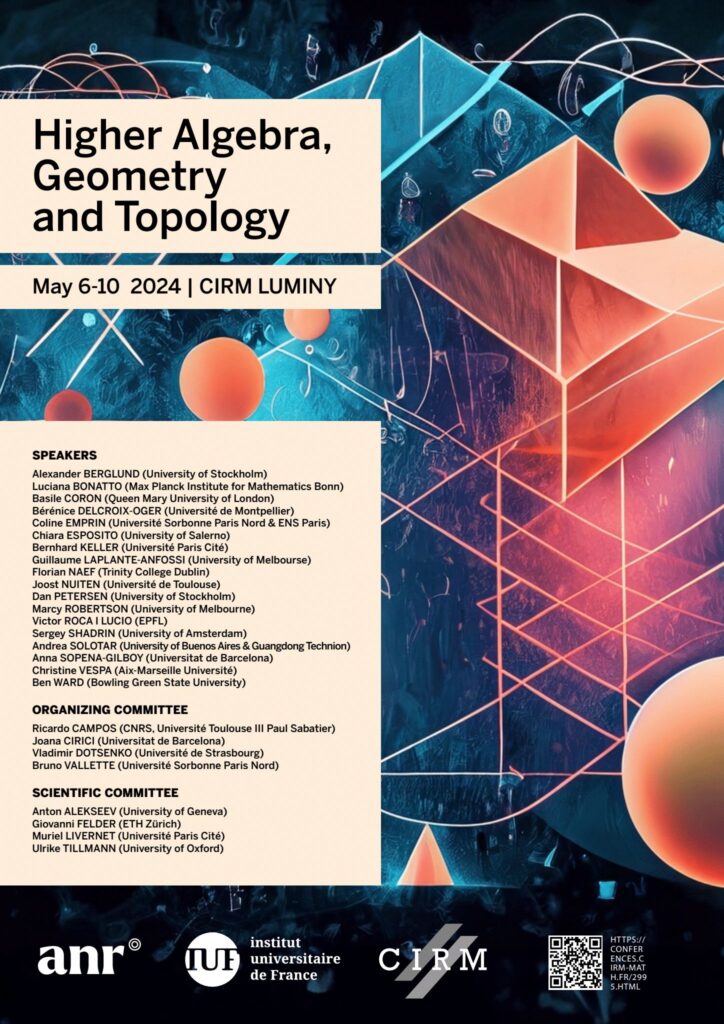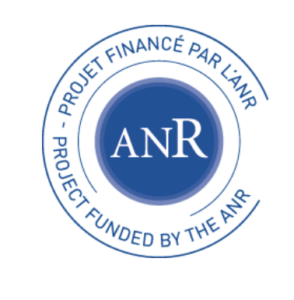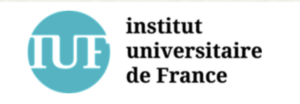Scientific Committee
Comité scientifique
Anton Alekseev (University of Geneva)
Giovanni Felder (ETH Zürich)
Muriel Livernet (Université Paris Cité)
Ulrike Tillmann (University of Oxford)
Organizing Committee
Comité d’organisation
Ricardo Campos (CNRS, Université Toulouse III Paul Sabatier)
Joana Cirici (University of Barcelona)
Vladimir Dotsenko (Université de Strasbourg)
Bruno Vallette (Université Sorbonne Paris Nord)
Preamble. Mathematics becomes suddenly more intricate and exciting when one does not compare anymore objects up to equality or up to isomorphism but under a more relaxed equivalence relation. The most illuminating example comes from topology where one studies topological spaces not up to equality or homeomorphism but up to homotopy equivalence, that is up to continuous deformations. This difficult but rich problem of classifying topological spaces up to homotopy prompted the creation of new domains in mathematics over the last century like algebraic topology, category theory, and homotopical algebra. In the last decades, such ideas have developed vastly past the original topological motivations in various directions.
Scientific context. The aim of the present conference is to gather mathematicians working in Algebra, Geometry, Topology, and Mathematical Physics. Created over the past 50 years, the theory of higher structures (operads, homotopy algebras, infinity-categories) has given rise recently to powerful tools which led to resolutions of open problems and prompted deep developments, for instance in algebraic topology (faithful algebraic invariants of the homotopy type of spaces), algebraic geometry (derived algebraic geometry), and deformation theory (formal moduli problems). More recent, fundamental achievements have been obtained by applying these effective and algorithmic higher algebraic methods in Lie theory (higher Lie
theory), derived deformation theory (deformation theory in positive characteristic, universal deformation groups, Grothendieck–Teichmüller groups), homotopy theories (rational homotopy theories), and geometry (algebraic, complex and discrete).
Present conference. We live nowadays a very exciting period of rapid mathematical development of higher structures. The aim of this conference is to cover the new foundational works on higher algebra together with its applications. Beyond the 20 one-hour talks, enough time will be scheduled to allow the various participants to discuss and to interact in order to broadcast their ideas and to initiate further joint collaborations.
This conference will be the closing event the project ANR « Higher Algebra, Geometry, and Topology », which structures the French community working on these topics:
Préambule. Les mathématiques deviennent subitement plus riches et excitantes lorsque l’on arrête d’essayer de comparer les objets à égalité ou à isomorphisme près et qu’on le fait à relation d’équivalence plus faible près. L’exemple le plus significatif vient de la topologie où on étudie les espaces topologiques, non pas à égalité ou à homéomorphisme près, mais à équivalence d’homotopie près, c’est-à-dire à déformations continues près. Ce problème profond et difficile de classifier les espaces topologiques à homotopie près est à l’origine de la création de nouveaux domaines au siècle dernier comme la topologie algébrique, la théorie des catégories et l’algèbre homotopique. Dans les dernières décennies, ces idées se sont diffusées dans de nombreuses directions, au delà des motivations topologiques initiales.
Contexte scientifique. Le but de cette conférence est de réunir des mathématicien.nes travaillant en Algèbre, Géométrie, Topologie et Physique Mathématique. Créée au cours des 50 dernières années, la théorie des structures supérieures (opérades, algèbre à homotopie près, catégories infinies) a donné naissance à des objets puissants qui ont permis la résolution de problèmes ouverts, par exemple, en topologie algébrique (invariants algébriques fidèles du type d’homotopie des espaces topologiques), géométrie algébrique (géométrie
algébrique dérivée) et théorie de la déformation (problèmes de modules formels). Plus récemment, des avancées fondamentales ont été obtenues en appliquant ces méthodes algébriques supérieures en théorie de Lie (théorie de Lie supérieure), théorie de la déformation dérivée (théorie de la déformation en caractéristique positive, groupes universels de déformation, groupes de Grothendieck–Teichmüller groups), théories de l’homotopie (homotopie rationnelle) et géométrie (algébrique, complexe et discrète).
Conférence présente. Nous vivons actuellement une période excitante de développement rapide des structures supérieures. Le but de cette conférence sera de couvrir les nouveaux travaux de fondation de l’algèbre supérieure ainsi que ses applications. En plus des 20 exposés d’une heure, de longues plages de temps libre seront mises à la disposition des participant.es pour discuter et pour interagir; cela leur permettra de diffuser leurs idées et d’initier de futures collaborations fructueuses.
Cette conférence sera l’événement qui conclura le project ANR « Algèbre, Géométrie et Topologie Supérieures » qui structure la communauté française sur ces thématiques nouvelles :
SPEAKERS
Alexander Berglund (University of Stockholm) Poincaré duality fibrations and graph complexes
Basile Coron (Queen Mary University of London) Operads and Kazhdan–Lusztig–Stanley theory
Berenice Delcroix-Oger (Université de Montpellier) From partition posets to operadic poset species
Coline Emprin (Université Sorbonne Paris Nord, ENS Paris) Kaledin classes and formality criteria
Chiara Esposito (University of Salerno) Equivariant formality and reduction
Bernhard Keller (Université Paris Cité) Triples of flags categorified
Florian Naef (Trinity College Dublin) Simple homotopy types in string topology
Joost Nuiten (Université de Toulouse) The infinitesimal tangle hypothesis
Dan Petersen (University of Stockholm) Stable homology of braid groups with symplectic coefficients
Marcy Robertson (University of Melbourne) Tangles, duality and weak props
Victor Roca i Lucio (EPFL) Higher Lie theory in positive characteristic
Sergey Shadrin (University of Amsterdam) The Givental–Grothendieck–Teichmueller group
Andrea Solotar (University of Buenos Aires, Guangdong Technion) Hochschild cohomology ring of triangular monomial algebras
Anna Sopena (University of Barcelona) Pluripotential Operadic Calculus
Christine Vespa (Aix-Marseille Université) On analytic exponential functors on free groups
Ben Ward (Bowling Green State University) Graph homology classes via hyperoctahedral symmetries





